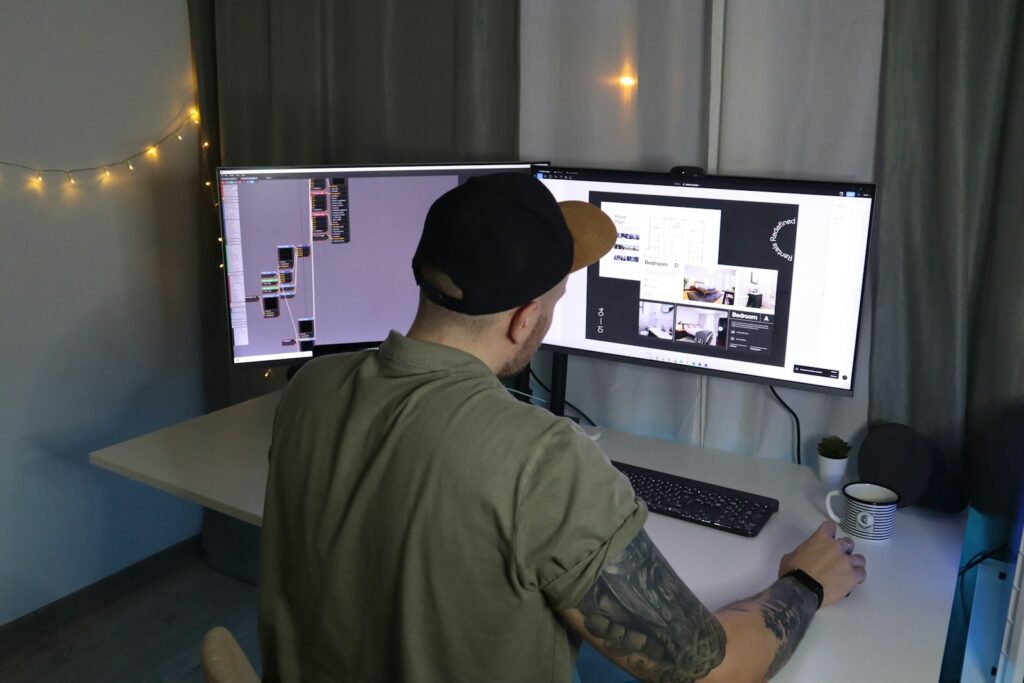Working together on designs from different places is, well, it’s just how things are now. It’s not even a suprise anymore. It used to be a big deal to have designers spread across offices, let alone time zones. But these days, remote collaboration is almost the default. So, the tools we use have to keep up. These tools aren’t just about sharing files; there about making the whole design process feel like everyone’s in the same room. Or at least, a very well equipped virtual room.
The Basics of Remote Collaborative Design
Let’s get the basics down. It all starts with having the right tools, obviously. But it’s more than just slapping some software on a screen and hoping for the best. It’s about creating a shared workspace where everyone can contribute, give feedback, and iterate without stepping on each other’s toes. The key is seamless integration and real-time updates.
Essential Tools
There are a few big players in the game. Figma is a huge one, with its browser based interface and real-time collaboration features. It’s great for UI/UX design, but also surprisingly effective for other design tasks. Then there’s Adobe Creative Cloud, which has been around for a while, but is catching up with features like shared libraries and co-editing. And don’t forget about Sketch, still a favorite among many designers, especially when paired with tools like Abstract for version control and collaboration. Even non design tools like Miro or Mural can be great for early-stage brainstorming and whiteboard sessions.
Setting Up a Shared Workspace
Okay, you have the tools. Now what? The first step is to establish clear guidelines for how everyone will use them. That means setting up consistent file naming conventions, establishing a clear folder structure, and defining roles and responsibilities. Think about it like setting up the physical workspace in a studio – where does the paper go? Who is responsible for the coffee machine? It’s the same, but digital. Some teams use project management software like Asana or Trello to keep everything organized. That can be a big help, especially on larger projects.
Common Mistakes
One of the biggest mistakes I see teams making is failing to communicate effectively alongside the design tools. You can have the most advanced software in the world, but if people aren’t talking to each other, giving feedback, and asking questions, it’s not going to work. Communication tools like Slack or Microsoft Teams are essential, but it’s important to use them strategically. Avoid endless back and forth threads. Try to schedule regular video calls to discuss progress, address concerns, and build relationships. Don’t rely on just typing messages. Its just doesn’t cut it when you need real, honest feedback.
Advanced Techniques for Collaboration
Once you’ve got the basics down, you can start exploring more advanced techniques to take your remote collaboration to the next level. This is where things can get really interesting – and really productive. It’s all about finding ways to replicate the spontaneity and creativity of in person collaboration, but in a virtual environment. The core principle is simple; create a fluid workflow.
Real-Time Co-Editing
Real-time co-editing is where multiple designers can work on the same file simultaneously. Figma is great for this, but other tools are catching up. The key here is to establish clear roles and responsibilities. Who is responsible for what? How do you avoid conflicting changes? One approach is to assign specific sections or elements of the design to different team members. That way, you can avoid stepping on each other’s toes and ensure that everyone is working on something that they’re good at. Another tactic is to use branching and merging workflows, similar to what developers use in software development. Its a bit technical, but it can be really effective for managing complex projects.
Asynchronous Feedback and Review
Not every team member will be available at the same time. Asynchronous feedback and review is the solution. Tools like InVision and Zeplin allow you to share designs and gather feedback from stakeholders at their own pace. The key is to provide clear instructions and ask specific questions. Don’t just say “What do you think?” Instead, ask “Does this color scheme align with the brand guidelines?” or “Does this layout effectively communicate the key message?” The more specific you are, the more helpful the feedback will be. And be sure to acknowledge and respond to all feedback, even if you don’t agree with it. It shows that you value the other person’s input and encourages them to continue providing feedback in the future. People appreciate knowing their ideas were heard.
Version Control and History
Version control is essential for any collaborative design project. It allows you to track changes, revert to previous versions, and avoid losing work. Tools like Abstract and Git for design provide robust version control features, but even simpler tools like Google Drive or Dropbox can be helpful. The key is to establish a clear versioning strategy. How will you name your files? How often will you create new versions? What information will you include in the version history? By establishing these guidelines upfront, you can avoid confusion and ensure that everyone is on the same page. One mistake many teams make is neglecting to document their versioning strategy. Write it down and share it with the team. Otherwise, people will forget or interpret it differently.
Overcoming Challenges in Remote Design
Remote design isn’t all sunshine and rainbows. There are some real challenges that you need to be prepared to address. These are common, and every team has to deal with some. From communication breakdowns to technical difficulties, there are plenty of potential pitfalls that can derail a project. But with the right strategies and tools, you can overcome these challenges and create a successful remote design workflow.
Communication Barriers
One of the biggest challenges of remote design is communication. Without the spontaneous interactions of an in person office, it can be difficult to build relationships, share ideas, and resolve conflicts. How do you overcome these communication barriers? One approach is to use video conferencing regularly. Schedule regular team meetings, design reviews, and informal social events. This helps to build rapport and create a sense of connection. Another tip is to use communication tools like Slack or Microsoft Teams strategically. Create dedicated channels for specific projects or topics. This helps to keep conversations organized and avoid information overload. Remember that written communication can easily be misinterpreted. Be clear, concise, and empathetic in your messages. Ask questions to clarify understanding and avoid making assumptions.
Technical Difficulties
Technical difficulties are another common challenge of remote design. Slow internet connections, software glitches, and hardware failures can all disrupt the design process. How do you mitigate these technical risks? One approach is to provide team members with the necessary equipment and software. Make sure everyone has a reliable computer, a fast internet connection, and the latest versions of the design tools they need. Another thing that can really help is to have a backup plan for when things go wrong. What happens if someone’s internet goes down? Do they have a mobile hotspot they can use? What if the software crashes? Do they have a recent backup of their work? By anticipating these potential problems and having a plan in place, you can minimize the impact of technical difficulties.
Maintaining Team Cohesion
Maintaining team cohesion can be difficult when everyone is working remotely. It’s easy for team members to feel isolated, disconnected, and unmotivated. How do you foster a sense of community and belonging in a remote team? One approach is to create opportunities for social interaction. Schedule virtual coffee breaks, team lunches, or happy hours. This gives team members a chance to connect on a personal level and build relationships. Another tip is to celebrate successes and recognize achievements. Acknowledge team members’ contributions and show appreciation for their hard work. This helps to boost morale and create a sense of shared purpose. Make sure you’re recognizing work, not just making polite statements. Otherwise it’s all just cheap talk.
Tips for Successful Remote Collaboration
Ok, so here are some real world tips that make all the difference. It’s not just about the technology; it’s about the people and the processes. Its about figuring out what actually helps a team and what just sounds good on paper. I think the real secrets is simple; get out of people’s way. Here are a few of my thoughts on that.
Establish Clear Communication Protocols
One of the most important things you can do is to establish clear communication protocols. How will team members communicate with each other? What channels will they use? How quickly are they expected to respond? By establishing these protocols upfront, you can avoid confusion and ensure that everyone is on the same page. It really depends on the team’s style, and culture. For some people, fast responses are really critical. For others, it’s more important to have time to think things over before replying. Just figure out what works for you. Then write it down.
Use Video Conferencing Regularly
Video conferencing is your friend. It helps to build relationships, share ideas, and resolve conflicts. Schedule regular team meetings, design reviews, and informal social events. This creates a sense of connection and helps team members to feel more engaged. If you can’t meet in person, video is the next best thing. Its the closest you can get to seeing the actual way somebody reacts to something, which can be important. I personally feel like it can be a little draining, so I wouldn’t want to rely on it all the time. But, it’s the best substitute for being there.
Document Everything
Documentation is key to successful remote collaboration. Document your design decisions, your processes, and your communication protocols. This helps to ensure that everyone is on the same page and that new team members can quickly get up to speed. One mistake I’ve seen teams make is failing to document their design rationale. Why did you make that design decision? What were the alternatives? By documenting your reasoning, you can avoid having to re explain everything later on. And it helps to ensure that everyone understands the goals and objectives of the design.
Embrace Asynchronous Communication
Asynchronous communication allows team members to work at their own pace and in their own time zone. Use tools like email, chat, and project management software to communicate and collaborate asynchronously. This is especially important for teams that are distributed across multiple time zones. It sounds simple, but its often overlooked. The whole point of remote work is that people should be able to be productive when and where they do their best work. Don’t just force people to adjust to the same schedules as everyone else.
Create a Culture of Trust and Autonomy
Trust and autonomy are essential for successful remote collaboration. Trust your team members to do their jobs. Give them the freedom and flexibility to work in a way that works best for them. Micromanaging is a recipe for disaster. You hired them for a reason. Let them do their thing. If you don’t trust them, you should probably find someone else. If you do trust them, just let them do what they do best. Sometimes I struggle to not ask to many questions, or worry too much. I’ve had to learn that if I am overly involved, it makes it harder for people to truly own the work.
Quick Takeaways
- Communicate clearly and often, even when it feels like overkill.
- Document everything – decisions, processes, feedback.
- Use video conferencing to build relationships and resolve conflicts.
- Embrace asynchronous communication for flexibility.
- Trust your team members and give them autonomy.
- Invest in the right tools and training.
- Remember that remote collaboration is a work in progress.
Conclusion
Remote collaborative design isn’t just a trend. It’s the future, and it’s already here. The tools are getting better, and teams are learning how to make it work. It’s not always easy, and there are challenges along the way. I’ve seen projects stall out because the communication wasn’t good enough, or because the technology wasn’t up to the task. But when it works, it really works. What I’ve learned the hard way is to make sure you start with really talented people. Otherwise, all the tools in the world won’t save you.
FAQ
Q – What if team members are in completely different time zones?
A – Focus on asynchronous communication. Document everything, set clear expectations for response times, and use tools that support collaboration across time zones.
Q – How do I get buy in from team members who are used to working in person?
A – Show them the benefits of remote collaboration. Highlight the flexibility, autonomy, and increased productivity. Involve them in the decision making process and give them a voice.
Q – What’s the best way to give feedback on designs remotely?
A – Be specific, constructive, and empathetic. Use tools that allow you to annotate designs and provide visual feedback. Schedule video calls to discuss feedback in more detail.
Q – How do I keep remote team members engaged and motivated?
A – Create opportunities for social interaction, recognize achievements, and give team members autonomy. Foster a culture of trust and support.
Q – What if I do not no what tools to use to get started?
A – Start with free or low cost tools like Figma’s free tier, or a free trial of Adobe Creative Cloud. Experiment and see what works best for your team. Don’t be afraid to switch tools if something isn’t working out.


